
















VP - COMMUNICATIONS
Janelle Guthrie
CONTENT SPECIALIST
Hannah Cassara
PRINCIPAL UX DESIGNER
EXECUTIVE VICE PRESIDENT
Greg Lane
WASHINGTON HOME BUILDERS
FOUNDATION DIRECTOR
Al Audette
VP - COMMUNICATIONS
Janelle Guthrie
VP - BUSINESS DEVELOPMENT
Bart Hansen
VP - EXTERNAL AFFAIRS
Jan Himebaugh
VP - OPERATIONS
Stephen Hyer
ROII DIRECTOR
Jenn Kavanaugh
VP - GENERAL COUNSEL
Ashli Penner
LEGISLATIVE DIRECTOR
Andrea Smiley
CONTACT US
Lena Anderson For editorial inquiries, contact hannahc@biaw.com Interested in advertising in Building Insight? Contact communications@biaw.com
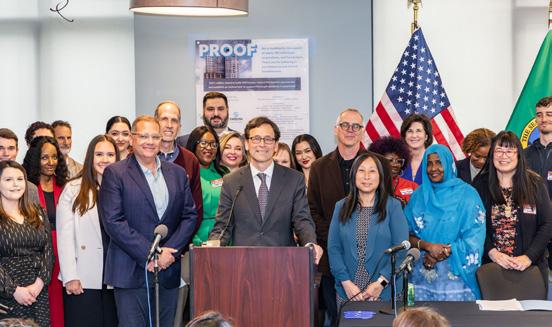

12 2025 legislative session recap: More costs and regulations, little relief
Overall, this legislative session was filled with mixed signals about whether the state is serious about solving our housing supply crisis. While some lawmakers are calling this session another “Year of Housing,” BIAW disagrees.
22 ROII delivers over $24 million in refunds
ROII participants have a lot to celebrate this year. Thanks to their continued commitment to safety, ROII is returning over $24 million in L&I refunds to participating businesses across Washington.
& homeownership
Prevent roofing injuries with SteepGear Shorts Local happenings
Stay Compliant with Washington’s Heat Rules Free safety training for ROII participants
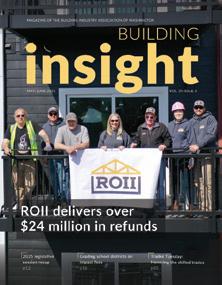
Building Insight magazine is published on behalf of the Building Industry Association of Washington by Print Northwest.
ROII visits Port Orchard to join the Disney and Associates team to celebrate safety and record refunds at their new multi-family housing project. Read more on page 22. ON THE COVER
As always, we want to hear from you! We invite you to take a quick survey about your thoughts on Building Insight. Happy reading!





Kent Arola President
Many of us recently returned from the National Association of Home Builders Spring Meeting and Legislative Conference.
The annual NAHB Legislative Conference is a chance for thousands of home building association members to meet face-to-face with members of Congress and their staff.
This year, the top priorities we brought to Congress included:
n Renewing tax laws that help consumers and businesses
n Reversing a disastrous energy code policy that places homeownership out of reach for families
n Easing the chronic workforce shortage by gaining co-sponsors for the CONSTRUCTS Act in both the House and Senate
Advocacy at the local, state and national level is a critical benefit of our membership—and I’m happy so many members joined us to take advantage of this opportunity to demonstrate the strength of our organization.
bills that make it even more costly to build single-family and multi-family structures for families to purchase or rent.
Legislators introduced nearly 2,000 bills in 2025, and they passed 421 of them.
Your External Affairs team reviewed every bill scheduled for a hearing and tracked 48 pages of bills throughout the session.
Of those, seven good housing bills made it through, including measures to:
n Increase housing options by allowing lot-splitting
n Streamline the subdivision process inside urban growth areas
n Simplify condominium construction laws
n Direct the Careers and Technical Education work group to recommend more opportunities for students to get work experience
At the same time, six really bad bills made it through the session, including:
n Rent control, which will kill the rental housing industry in Washington
BIAW LEADERSHIP
PRESIDENT
FIRST VICE PRESIDENT/TREASURER
Aaron Marvin
SECOND VICE PRESIDENT
Nick Gilliland Kent Arola
THIRD VICE PRESIDENT
Matt Willard
SECRETARY
Andrew Northrop
IMMEDIATE PAST PRESIDENT
Jay Roberts
I also want to thank our outstanding External Affairs and Legal teams as well as our Executive Vice President Greg Lane for supporting us in DC, arranging all our meetings, preparing us to effectively lobby and making sure we had a great time.
A tough state legislative session
I’m especially grateful to these two teams after the brutal legislative and legal challenges they’ve faced in the first part of 2025.
Despite claiming housing was a top priority for the 2025 legislature, lawmakers passed millions of dollars in new taxes and a number of new
n Expanding the state’s Paid Family and Medical Leave programs which could cripple small businesses if their employees have to use it
n Allowing striking workers to get unemployment insurance
A huge thank you to the external affairs team and our skilled team of contract lobbyists for all their tireless work this session. And thank you to all the members who participated in helping them at news conferences, testifying in committee or simply answering our calls to action to show support or oppose bills. We see you and we appreciate you!
Look for our list of the 2025 Legislative Champions in the next edition of Building Insight
Continuing the fight to protect natural gas
Another huge thank you to our BIAW General and Associate General Counsel, as well as to our outside counsel, for their continued work to protect natural gas as an energy source by fighting for the constitutionality of I-2066 in court. I was proud to join the team in the courtroom (along with former Gov. Jay Inslee!) as they argued for the judge to uphold the constitutionality of I-2066. When we saw Inslee and the judge make eye contact and acknowledge each other, we knew no matter what we said, our opponents were going to win. We
weren’t surprised in the least when that King County judge, appointed by Gov. Inslee, came out with her biased ruling claiming I-2066 was unconstitutional. We look forward to getting a fresh start before the Washington State Supreme Court soon. Thank you to the legal team for all your hard work.
Investing in the workforce of the future
Finally, I want to recognize the hard work of our Washington Home Builders Foundation and the staff supporting it and the new Construction Trades Training Center. We’ve now graduated two full cohorts of students and helped them connect with builders to use their new skills. At the BIAW Summer Board meeting, we’re asking the board to
approve moving $250,000 from BIAW’s reserves into the foundation to continue the great work and continue our investment in our future.
As I enter the second half of my year as your president, I’m so proud of the work we are all doing together for our industry. I look forward to seeing more of you all as I continue to travel around the state to all the local associations.



Greg Lane Executive Vice President
Lawmakers kicked off the 2025 session claiming this was going to be the “Year of Housing,” but despite a few bright spots, most of the “solutions” coming out of Olympia will do nothing to lower costs or increase the supply of new homes.
While we succeeded in passing a handful of good bills to make permitting and development slightly less painful, we had to fight tooth and nail to stop a tidal wave of bad legislation.
What we fought for—and won
n HB 1096 - Increasing housing options through lot splitting
n SB 5559 - Streamlining the subdivision process inside urban growth areas
n HB 1403 - Simplifying condominium construction laws
n HB 1576 - Historic landmark designations
n SB 5611 - Allowing permitting of residential housing in commercial areas for redevelopment
n HB 1414 - Directing the Careers and Technical Education work group to recommend more opportunities for students to get work experience
n SB 5408 - Providing an opportunity to update a job posting that violates Washington’s wage and salary disclosure law without penalty.
Bills we killed
n SB 5360 - Expanding criminal penalties for environmental violations
n HB 1254 - Implementing the flawed wildland urban interface
n HB 1303 - Environmental justice in State Environmental Policy Act (SEPA)
n HB 1015 - Energy labeling/residential
n HB 1402 - Prohibiting some employers from posting driver’s license requirements
n HB 1155 - Prohibiting noncompete agreements
We’ll continue fighting to restore balance and protect the people who actually build the homes for Washington’s families.
Energy choice initiative appeal filed
We’re also not backing down from defending Initiative 2066, protecting energy choice. After a politically motivated King County judge tried to toss out the voice of nearly 2 million voters, we immediately partnered with the Attorney General’s Office to appeal directly to the Washington State Supreme Court.
We’re confident the Washington State Supreme Court will reject this constitutional challenge as the frivolous claim it is. Washington families deserve the right to choose how they heat their homes.
On a more positive note, we’re proud to announce that the second cohort of students from the new Construction Trades Training Academy (CTTA) completed their training on June 6. The Academy now has a total of 26 graduates. We invite you to make a difference in the lives of the Academy’s students and their communities by donating to the Washington Home Builders Foundation. All contributions are eligible for charitable tax deductions. Learn more at biaw.com/donate.
delivers yet again
And, last but not least, please join me in congratulating our amazing ROII staff on yet another great return. Thanks to our participants’ continued commitment to safety, ROII is returning over $24 million in L&I refunds to participating businesses across Washington.
These impressive results show the ROII program’s consistent strength and that it is truly the number one retro program in Washington.
If you’re not already in ROII, now’s the time to take a closer look. Visit ROII.com to see how much you could save.

“Building spaces that transform lives is more than a job—it’s a privilege,” Wilson said. “Whether it’s creating dream homes or supporting my kids on the field and court, I embrace every challenge with dedication and heart.”
Reier Construction works with outstanding architects, expert designers,
and the finest craftsmen to make sure their customers’ visions come to life. The company takes pride in knowing the homes and spaces they build will house memories to last a lifetime.
Learn more about Reier Construction at reiercustomhomes.net.
by Hannah Cassara Content Specialist
Dedicated staff member to help achieve maximum success
A dedicated and busy wife, mother, and bookkeeper for Reier Construction, Lucy Wilson’s journey into the construction industry was unexpected. Today, she is BIAW’s newest Certified Builder.
Builder toolkit with professional marketing templates, logos, approved language and more that you can personalize display digitally and in person
marketing campaign to give you and company more exposure
Wilson began working as a bookkeeper in 2018 after earning a degree in Business Administration with a major in accounting. Within six months, she moved into project development, where she found her stride.
with interactive map so potential can find Certified Builders in their area
Today, she manages everything from estimating and sales to design coordination and execution, working directly with clients, trade partners, and vendors to ensure each project stays on track.
opportunity access to BIAW events and discounts on BIAW-partnered educational and classes
An active member of the Master Builders Association of Pierce County, Wilson has served on the steering committee for the association’s Professional Women in Building (PWB) Council. This year, she stepped into the role of PWB Vice Chair.

BIAW’s Certified Builder designation bridges the communication gap and offers more transparency between builders and home buyers.
Becoming a Certified Builder shows your clients that you are completely vetted and creates a sense of trust.
by Hannah Cassara Content Specialist
Associate members make up 66% of the National Association of Home Builders (NAHB) membership. They include dedicated suppliers, service professionals and manufacturers, and they are fundamental to the strength of both our industry and our association.
BIAW’s Associate Advisory Council proudly hosts the annual Associate Star Awards each year at the BIAW Fall Board Meeting. Join us in honoring two recent recipients of these awards: Bonnie Buffington of the Master Builders Association of Pierce County (MBAPC) and Jordan Thayer of the Master Builders Association of King & Snohomish Counties (MBAKS).

Master Builders Association of Pierce County
With over 22 years of experience across all areas of the title industry, CW Title’s Sales Manager and Builder Specialist, Bonnie Buffington, offers her clients a seasoned approach, delivering a seamless title and escrow experience. She possesses real-time marketing tools and stays closely connected to the activities of brokers, lenders and the new construction real estate market.
Additionally, Buffington is a licensed real estate appraiser, instructor and notary. She has been recognized as the Washington Realtor Association Affiliate of the Year, the Tacoma Pierce County Association of Realtors Affiliate of the Year, and the Associate of the Year by MBAPC.
Past Second Vice President of MBAPC, Buffington was the leading force behind starting the MBAPC Professional Women in Building Council, serving as the council’s chair in 2024. An active member and recruiter, she won the 2024 MBAPC membership drive by bringing in 12 new members between April and August.
Over the past 20 years, CW Title has built a team dedicated to ensuring that those who call Washington home receive world-class title and escrow services from a local company providing local expertise. To learn more, visit www.cwtitle.com

Master Builders Association of King & Snohomish Counties
Jordan Thayer grew up with a financial advisor as a father. When he became an officer in the Marine Corps Reserves, he fell into the role of financial counselor with his fellow Marines, many of whom were looking for guidance in making wise financial choices.
Now, as Vice President, Wealth Management, Financial Advisor, and Portfolio Manager for Morgan Stanley, Thayer’s first goal is to learn what his clients are working towards. He then creates a step-by-step plan that provides a template for their financial lives, allowing them to focus on what really matters: building a life for themselves and their families.
An active member of MBAKS, Thayer has served on the Sales & Marketing Council and the Remodelers Council. In 2019, he received an MBAKS Life Spike Award. At Morgan Stanley, clients come first. They have global expertise in market analysis and in advisory and capital-raising services for corporations, institutions and governments. Learn more at www.morganstanley.com
CESCL (Certified Erosion & Sediment Control Lead)
July 9 | Online
CESCL Recertification
July 11 | Online
Heat Stress Training*
July 15 | Online
When You’re on the Hook: Subcontractors, Safety, and Liability*
July 16 | Vancouver
DOSH Inspections: Don’t Be Caught Unprepared* July 23 | Online
Certified Lead Renovator – Initial July 29 | Tumwater
Certified Lead Renovator – Refresher July 29 | Tumwater
Help Minimize Risk:
Condition Your Workforce for Safety* August 7 | Online
Project Management August 14 | Bellingham
CESCL (Certified Erosion & Sediment Control Lead) August 27 | Online
CESCL Recertification

- Minimize liability and reduce financial risk.
- Attract more buyers and boost the home’s value.
- Wide range of warranty options and terms.
- Our free mediation process resolves about 95% of claims.
Felbaum / 800.247.1812 x2633 / sales@rwcwarranty.com www.rwcwarranty.com
August 29 | Online *FREE FOR ROII PARTICIPANTS
Scan the QR code to learn more and register.



As we continue to reflect on BIAW’s 75 years of history, we thought it would be fun to look back on some home remodeling trends as well as the cost of homeownership and rent over the years. Every May, the National Association of Home Builders (NAHB) recognizes National Home Remodeling Month to honor the expertise of trained remodeling professionals. And each June, the housing industry celebrates National Homeownership Month to remind consumers about the evolving role of the home and its importance in our lives.
From 1950 to 2025, national home values increased dramatically from $7,400 to $614,235, while median rent across the nation rose from $42/month to $1,731/ month.
Over the same period, the national median household income increased from $2,990 to $80,610. This goes to show that home prices and rent costs have skyrocketed compared to income, making housing far less affordable than it used to be.
No matter the year, a home is something that connects us all. And as the years and seasons change, so do homeowners’ styles, wants and needs for their living spaces. BIAW’s Excellence in Remodeling (EIR) Awards showcase the best of the best of Washington remodels. Join us in

This bathroom remodel by Tenhulzen Remodeling, Inc., won the 2010 BIAW EIR Award for Bath Over $75,000. At the time, a built-in soaking tub with a deck surround was the go-to for high-end bathrooms.

Phase II Inc. won last year’s EIR category of Bath Over $80,001 with this stunning remodel, which featured a freestanding tub as the focal point of the space.

This 2010 kitchen remodel by Westhill, Inc. Design/Build won the BIAW EIR Award in the category of Kitchen Over $125,000. Popular trends included heavily patterned granite countertops, white cabinetry, raised seating at the island, and neutral colors and earthy tones.

Last year’s EIR category of Kitchen Over $140,001 was a tie between a design by Lakeville Homes by SoBella and Choice Carpentry. Over the years, earth tones for the cabinetry have become the trend, in addition to lighter and matte-finished countertops.
comparing some of the different trends from 2010 to 2024.
Make sure to look out for the next issue of Building Insight featuring the winners of BIAW’s 2025 Excellence in Remodeling Awards.
Have a memory or historical tidbit to share? Contact communications@biaw.com.
by Janelle Guthrie Vice President - Communications
The future of natural gas in Washington remains in limbo as BIAW awaits a decision by the Washington State Supreme Court. On May 27, BIAW and the Washington State Attorney General’s Office filed their appeals to the Washington State Supreme Court in the constitutional challenge to Initiative 2066.
The court first must announce whether it will hear the case, then BIAW will learn when they’ve scheduled the case for oral argument.
A fresh chance to preserve energy choice
Initiative 2066, passed in November by nearly two million voters, protects natural gas as an energy choice.
BIAW filed the initiative after spending years fighting multiple efforts to ban or restrict natural gas as an energy choice in Washington.
“After years of opposing political efforts to ban natural gas in Washington, BIAW fought back at the ballot box,” said BIAW’s Executive Vice President Greg Lane. “We crafted I-2066 carefully with a singular goal – preserving natural gas as an energy choice for current and future homeowners. And every step of the way, opponents have filed lawsuits seeking to stop us.
“We’re confident the Washington State Supreme Court will reject this constitutional challenge as the frivolous claim it is,” he said.
Shortly after BIAW filed the initiative, I-2066 opponents mounted an unsuccessful legal challenge to the initiative’s title, delaying the ability to gather signatures.
Despite this, BIAW and natural gas proponents gathered more than a half a
million signatures in just seven weeks. Opponents then filed an unsuccessful lawsuit challenging the certification process.
Constitutional challenge keeps natural gas choice in limbo
Environmental groups, the City of Seattle and King County challenged the constitutionality of the new initiative in King County Superior Court shortly after it passed in 2024.
That case claims the initiative is unconstitutional because it violates the single-subject, subject in title, and amendment by reference requirements in the Constitution.
BIAW and the Washington Attorney General’s Office countered these arguments.
“Every single section of 2066 addresses protecting the choice to access and use natural gas,” Lane said. “Because the governor and other political proponents used every avenue available in their quest to ban natural gas, there were many places in state law that needed to be changed to ensure that customers continue to have an energy choice.
“And that’s what 2066 does—ensures Washington residents and businesses can access natural gas if they want it,” Lane said.
King County judge rules as expected
King County Superior Court Judge Sandra Widlan heard the constitutional challenge to I-2066 on March 21 with former governor Jay Inslee in the courtroom. Inslee, who appointed Widlan, made banning natural gas a top priority during his time as governor.
Shortly after hearing arguments, Widlan issued an oral ruling in favor of the
Plaintiffs. She then waited nearly two more months before filing the final order, delaying the ability to appeal and keeping the initiative implementation on hold.
Technically, laws ruled unconstitutional remain in effect until the judge issues her final order with the court. Now that the AGO and BIAW have filed their appeal, the question of I-2066’s constitutionality remains unanswered.
“That means local jurisdictions may still allow permits for natural gas until the Washington Supreme Court rules,” Lane said. “Members building in jurisdictions that were adapting to the requirements of I-2066 may be able to persuade building code officials to continue issuing permits in accordance with I-2066 until the Washington Supreme Court ultimately rules.”
BIAW and the Attorney General’s Office filed their statements of grounds for direct review with the court on June 11.
If the Supreme Court accepts direct review of the I-2066 case, the case may be set on the court’s calendar for the fall or winter. If the Supreme Court denies direct review, they will automatically transfer it to the Court of Appeals for determination.
If you have questions about this case or the implementation of I-2066, contact BIAW’s General Counsel Ashli Penner at AshliP@biaw.com or (360) 352-7800 x 118.
by Andrea Smiley Legislative Director
The legislative session began this year with the majority party promising to address the housing crisis by passing bills to increase the housing supply. Unfortunately, the gap between political rhetoric and reality couldn’t be more apparent.
While some lawmakers are calling this session another “Year of Housing,” BIAW disagrees. While some minor reforms may help spur a few new housing starts, the legislature did more harm than good to private sector homebuilding. As such, this year’s housing winners
were government-subsidized affordable housing developers; think nonprofits and public housing agencies.
While the government-backed industry segment will always have a place in the housing ecosystem, our state cannot afford to build its way out of the housing

crisis, at least not without private development. Let’s face it: subsidized housing relies on the success of a healthy private homebuilding presence, as our members pay fees and taxes (some bookmarked for governmentbacked building) at each stage of the homebuilding process. The blatant refusal to address rising building costs doesn’t help subsidized housing build more units with your tax dollars, nor allows the free market to provide costeffective homes for Washington families.
Let’s break down the good, the bad, and the ugly of this session—and what it all means for the builders to keep up with demand, stay in business, pay their employees livable wages, and build the communities in which they live.
HB 1096 by Rep. Barkis passed the finish line this year. This legislation will allow property owners to administratively split their lot once (if certain requirements are met) and sell it to add light-density housing types in existing neighborhoods.
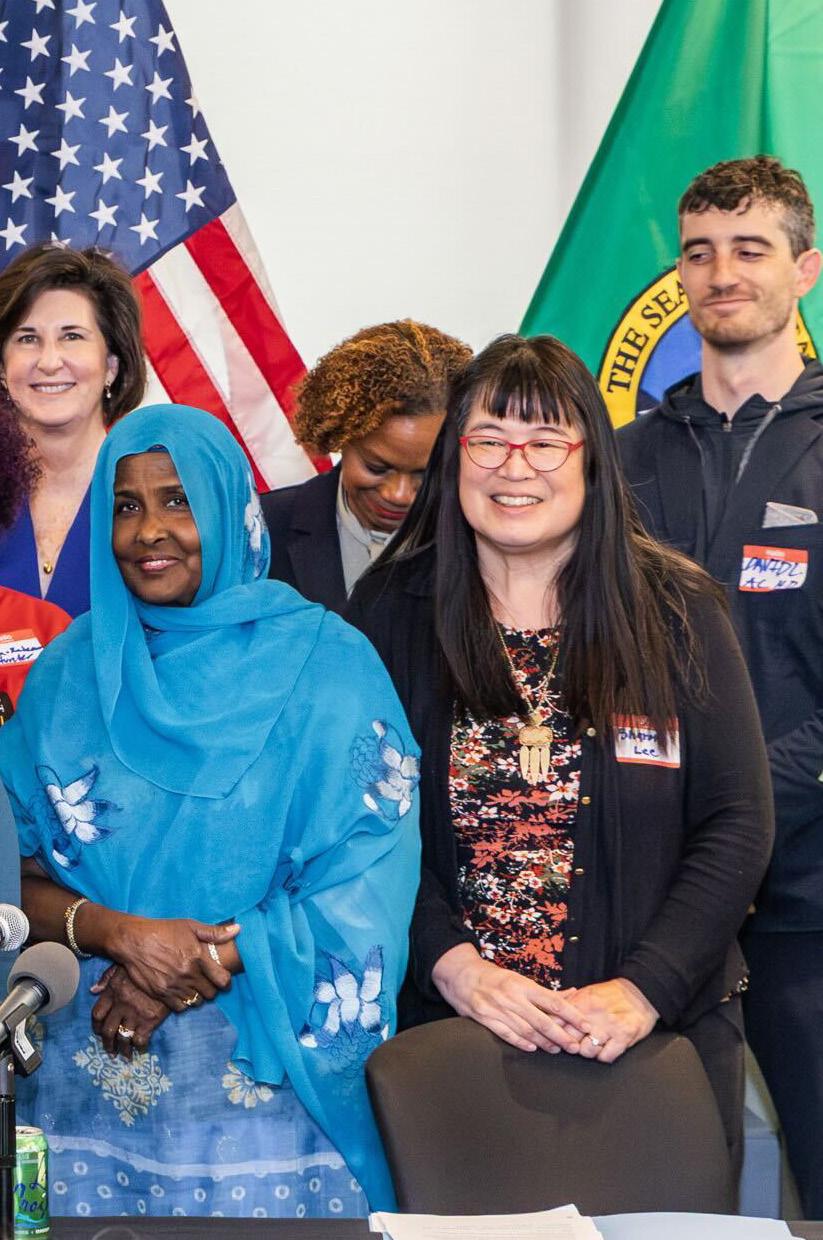
SB 5559 by Sen. Lovelett complements HB 1096 by essentially allowing the same lot splitting to occur at the development level.
HB 1403 by Rep. Taylor allows condo developments with 12 or fewer units (and no more than three stories) to offer a 2-10 Homebuyers Warranty instead of being bound to the statutory implied warranty provisions currently killing the viability of condo development.
SB 5148 by Sen. Bateman is dubbed the Housing Accountability Act. If cities and counties don’t meet the housing goals outlined in their comprehensive plans, they may lose eligibility for infrastructure funding from the state.
SB 5611 by Sen. Salomon improves the utilization of a binding site plan for multi-family residential projects, saving members the hassle (and expense) of going through the subdivision process. Perhaps more importantly, this legislation makes it illegal for a jurisdiction to make you waive your right to a speedy permit review as authorized in SB 5290 (unless substantiated and agreed upon in writing by both parties).
SB 5184 by Sen. Bateman aims to reform parking mandates by prohibiting cities and counties from requiring more than half a parking space per residential dwelling unit and off-street parking as a condition of project approval.
HB 1576 by Rep. Walen places restrictions on designating historical landmarks. Before this legislation, your neighbor could establish your home (or property) as a historical landmark without your knowledge or permission. Seattle has at least 60 examples of predatory landmarking to stop housing growth.
2025 LEGISLATIVE SESSION BY THE NUMBERS
105
Days the Legislature was in session
1,905
Total bills introduced by the House and Senate
421 Bills passed this session
48
Pages of bills your BIAW advocacy team tracked this session
7
Good building industry bills passed
6
High-profile non-tax-related bills we killed
6
Bad bills we tried to kill - some of which we managed to improve slightly before they passed
$77.9
Billion approved as Washington’s 2025-27 general fund operating budget
BIAW was proud to stand alongside Governor Ferguson in Seattle as he signed several important housing bills into law. We worked hard to help shape these bills on behalf of our members. From making condo construction more viable (HB 1403) to cutting red tape for multi-family projects (SB 5611) to reducing costly parking mandates (SB 5184), these new laws represent real wins for builders and for housing supply in Washington.
1,366
Pages in the 2025-27 operating budget
HB 1414 by Rep. Connors directs the state career and technical education task force to recommend changes to improve training, certification and employment opportunities for 16- and 17-yearolds in career and technical education programs.
SB 5408 by Sen. King aims to reduce frivolous lawsuits over nondisclosure of wage and salary information in job postings. The legislation allows employers to correct non-compliant postings before enforcement actions are taken and exempts job postings on thirdparty services that are published without the employer’s consent.
Bad for business or missed opportunities
HB 1491 by Rep. Reed is a missed opportunity for transit-oriented development projects. The requirements stipulate that 10% of all units must be affordable, another 10% must be workforce housing (if 10% of all units have 2+ bedrooms), or 20% must be dedicated to workforce housing. While the legislation allows a reduction in impact fees with a 20-year Multi-Family Property Tax Exemption (MFTE), BIAW’s assessment remains that the affordability requirements will render this program underutilized.
HB 1494 by Rep. Ramel is another missed opportunity that expands the MFTE program to any city with a population of 15,000 if mandatory inclusionary zoning is required. Counties with an unincorporated population of at least 170,000 can also offer MFTE, but only if they have a campus of higher education with on-campus housing or are in Clark, Kitsap or Snohomish Counties, where projects are located a half mile from a transit station.
HB 1308 by Rep. Reed is bad for business, as it requires employers to provide an employee or former employee with their personnel file within 21 days of a request. If not provided, the bill authorizes a private cause of action, thus making it easier for employers to be sued.
HB 1788 by Rep. Richards will increase workers’ compensation costs for employers and employees because the
legislation expands benefits based on marriage status and household size.
HB 1213 by Rep. Berry eliminates small business protections in the state’s Paid Family Medical Leave (PFML) program, resulting in devastating effects for small employers over the next three years. By January 1, 2028, employers with eight or more employees must offer PFML benefits.
SB 5041 by Sen. Riccelli grants unemployment benefits to striking workers. Initially, the bill included coverage for strikes lasting 12 weeks. Through negotiations, the coverage was revised to allow for six weeks of benefits with an extended waiting period before a claim can be filed.
The building industry left the tax battle relatively unscathed compared to other sectors. Still, the consequences of even minor tax increases can devastate builder confidence, housing starts, company profitability and the cost of household goods.
HB 2081 by Rep. Fitzgibbon permanently increases the Business and Occupation Tax (B&O) to 0.5% of gross revenues. Any company with $250 million in annual revenue also received a three-year surcharge of 0.5%, beginning January 1, 2026. While the surcharge won’t necessarily hit our builder members, it will continue to increase the costs of construction and household goods because retailers, wholesalers and other segments of the construction supply chain will be impacted.
SB 5814 by Sen. Frame expands the retail sales tax to previously exempt services such as IT, advertising, security, and temporary staffing. Expect these business costs to increase as the changes to the tax code begin to take effect.
SB 5813 by Sen. Claire Wilson modifies the structure and rates of capital gains and estate taxes. For example, the capital gains tax must be paid on gains between $270,000 and $1 million at a rate of 7% and 9.9% on $1 million or more. Our members should contact their financial planners to ensure their business succession and retirement plans are still on track.
SB 5794 by Sen. Salomon repeals tax preferences that the Department of Revenue cites as underutilized or no longer relevant. Costs will likely increase for insurance, title insurance (thus increasing costs for homebuyers), banking, and self-storage.
SB 5161 by Sen. Liias will increase the gas tax by six cents for gasoline and nine cents for diesel and automatically increase with inflation at a rate of up to two percent. Additionally, vehicle-related transaction fees such as registration, identification cards, tires, and car rentals will increase.
HB 2049 by Rep. Bergquist initially sought to increase the property tax cap from 1% to 3%. After record-breaking levels of citizen opposition, the legislation was pared down to allow more funding at the local level. This will enable more affluent areas to pay more via property taxes to support their districts, while poor districts are left behind. Sounds equitable, doesn’t it?

HB 1217 is surrounded by controversy, as former Rep. Alvarado introduced the legislation in the House of Representatives and then was appointed to the Senate to fill a vacancy. Further controversy surrounds the lawmaker’s employer, her role as a legislator, and potential ethical violations. It’s worth a Google search.
Turning to the legislation, HB 1217 originally proposed a 7% cap on rent increases for residential rentals. However, after a series of amendments passed through the Senate and some procedural drama unfolded, we were ultimately left with a final version that included annual rent increases of 7% + Consumer Price Index with a 10% absolute cap.
There is a 12-year exemption for newly constructed units, and a sunset of the policy in 15 years, unless extended by the legislature. Mobile home housing providers are the biggest losers as their annual rent increase cannot surpass 5%.
The legislation also makes changes to the notice provisions and fees that residential housing providers can charge:
n Maximum rent increases require at least 120 days’ notice, whereas all other lower rates of rent increases require 90 days’ notice.
n A maximum late fee of $75 will be charged if rent is paid within the fiveday grace period.
n Limits security deposits to one month’s rent.
n Removes the ability to charge movein fees.
n Tenants can break the lease agreement with 30 days’ notice for month-to-month tenancies and 45 days for fixed-term tenancies. No fees may be assessed for termination.
SB 5360 by Senator Trudeau thankfully died this year, as it would’ve created a new regime for environmental crimes. The bill would’ve established new crimes and higher penalties that would’ve made crimes against the environment more severe than most violent crimes.
HB 1254 by Rep. Duerr would’ve undone last year’s compromise between firefighters, builders and the environmentalists. If passed, the bill would’ve given the State Building Code Council full authority to enact all provisions of the costly Wildland Urban Interface Code (WUI). Full implementation would increase new construction costs and send the wrong signals to an already weak insurance market, threatening coverage options for Washingtonians.
HB 1303 by Rep. Mena would’ve placed a heavier emphasis on environmental justice in the State Environmental Policy Act (SEPA), basically undoing all the improvements made in recent years to streamline this segment of permitting. While residential
construction had an exemption, the bill’s overall impact would’ve stopped economic development, limiting livable-wage employment prospects for Washingtonians.
SB 5109 by Sen. Kauffman would’ve increased the Deed of Trust fee from $1 to $5 to fund more mortgage fraud prosecutions. According to members, Washington already has one of the most robust operations for prosecuting mortgage fraud. BIAW was pleased to see this bill die this year.
HB 1015 is another doozy by Rep. Duerr. This bill would’ve required jurisdictions to require sellers to obtain an energy audit at the point of sale. The bill could’ve devastated sellers with older homes, many relying on their home equity to fund their retirement.
Overall, the legislative session was filled with mixed signals about whether the state is serious about solving our housing supply crisis.
Case in point: Governor Ferguson vetoed HB 1108 by industry ally Rep. Klicker. The bill would’ve studied the primary cost drivers for producing new housing units – think Growth Management Act, Energy Code, and other Washingtonspecific regulations. We’re told the veto is a result of budgetary constraints of this biennium, despite the governor signing $9 billion in new revenue (aka, taxes).
Interestingly, HB 1108 has a fiscal note of less than $234,000, whereas HB 1516 by Rep. Hill (a study of insurance options for permanently affordable homeownership units) is estimated to cost $370,000
Sign up for advocacy alerts at biaw.com/ take-action-center.

$9.37
Billion in state tax increases over the next four years were approved by the Legislature to fund their budget
$ 3
BIllion in local tax increases
$2,000
Estimated annual tax increase per family of four in Washington
$ 39.7
Billion is the amount Washington’s budget has increased in just the last 10 years
11+
Types of tax and surcharge increases making up the $9.37 billion in new taxes
THANK YOU TO OUR MEMBERS
Total bills BIAW requested members to sign-in on
18,515
Total member sign-ins
1,002
Logins from 145 different members to the Tuesday BIAW Legislative Briefings, with 62 average attendees each week
by Riley Helean External Affairs Coordinator
When it comes to assessing school impact fees onto new home buyers, some school districts make the honor roll. Others need to go to detention.
“Impact fees are just one more way to restrict accessible affordable new homes in Washington,” said Greg Lane, BIAW Executive Vice President. “Imposing school impact fees already unfairly burdens new construction with the entire cost of increased school enrollments. But some districts compound the problem by improperly assessing these fees on new construction even when there isn’t actual enrollment growth. Those districts are failing their communities.”
BIAW’s Washington Center for Housing Studies recently launched a new study about how school districts levy impact fees due to their considerable impact on housing affordability. Find out who made the grade.
This analysis grades districts on the overall implementation of our current, flawed impact fee system. Districts receive higher grades based solely on their performance within that flawed system.
This study also only grades districts that have recently or actively collected school impact fees. Consequently, the resulting grades in this study are intentionally designed with an inherent curve.
While districts that historically have not collected impact fees are not included in this report, they receive the highest grades and most favorable views.
“Some school districts recognize that the law requires impact fees to only pay for new increased growth for new capacity and use their power to levy impact fees judiciously or not at all,” Lane said. “Those districts receive an “A” in our book.”

Those districts include:
Federal Way School District
Enrollment Change 22-23 to 23-24: 7
Enrollment Change 23-24 to 24-25: 8
Online Projections Accessible: Yes
Projected a Decrease for 24-25: No
Impact Fee Amount: 9
Monroe School District
Enrollment Change 22-23 to 23-24: 5
Enrollment Change 23-24 to 24-25: 11
Online Projections Accessible: Yes
Projected a Decrease for 24-25: No
Impact Fee Amount: 8

Sumner-Bonney Lake School District
Enrollment Change 22-23 to 23-24: 8
Enrollment Change 23-24 to 24-25: 8
Online Projections Accessible: Yes
Projected a Decrease for 24-25: No
Impact Fee Amount: 7
“Local governments should be allowing and encouraging development because new homes and economic development increase the tax base for all local services, including schools,” Lane said.
“Instead of driving up costs to construct new homes by imposing outrageous school impact fees, school districts and
government officials should work on reducing the overall cost of construction so new homes AND school capacity are less expensive for everyone,” he said.
A full one-third of the school districts in the study received Ds or Fs, mostly because they continued to collect impact fees despite declining school enrollments, driving up the cost for new homes without any clear need for increased capacity.
Two districts received an F-. That’s because they imposed impact fees without any clear growth rationale. Those districts are:
Evergreen School District
Enrollment Change 22-23 to 23-24: 2
Enrollment Change 23-24 to 24-25: 5
Online Projections Accessible: Yes
Projected a Decrease for 24-25: Yes
Impact Fee Amount: 5
Issaquah School District
Enrollment Change 22-23 to 23-24: 5
Enrollment Change 23-24 to 24-25: 3
Online Projections Accessible: Yes
Projected a Decrease for 24-25: Yes
Impact Fee Amount: 3
Each school district was evaluated on a 30-point scale, with three primary components:
1. Enrollment Change (2022–2023 to 2023–2024) – 10 points
2. Enrollment Change (2023–2024 to 2024–2025) – 10 points
Enrollment Growth Scoring
For both enrollment change periods, districts received points based on the percentage change in enrollment:
-4.0% to -3.2% = 1 point
-3.2% to -2.4% = 2 points
-2.4% to -1.6% = 3 points
-1.6% to -0.8% = 4 points
-0.8% to 0% = 5 points
0% to 0.8% = 6 points
0.8% to 1.6% = 7 points
1.6% to 2.4% = 8 points
2.4% to 3.2% = 9 points
3.2% to 4.0% = 10 points
For districts that exceeded or declined 4% growth, we awarded or subtracted additional points in 0.8% increments. For example, a district that grew by 5.6% would receive 2 extra points.
3. Impact Fee Amount – 10 points
Districts scored points based on the amount of their impact fees:
$1 – $1,000 = 10 points
$1,000 – $2,000 = 9 points
$2,000 – $3,000 = 8 points
$3,000 – $4,000 = 7 points
$4,000 – $5,000 = 6 points
$5,000 – $6,000 = 5 points
$6,000 – $7,000 = 4 points
$7,000 – $8,000 = 3 points
$8,000 – $9,000 = 2 points
$10,000 – $12,000 = 1 point
$12,000+ = 0 points
If a district calculated impact fees but did not actively collect them, it received an automatic pass.
Additionally, we offered:
1. Capital Facilities Plan
Availability Bonus
Districts that had an easily accessible, recently updated CFP received 1 point of extra credit.
2. Enrollment Decline Penalty
Districts that projected an enrollment decrease and collected impact fees for 2024–2025 were automatically penalized 10 points. This penalty reflects the fundamental issue of collecting impact fees while anticipating a decline in student population, which runs counter to the purpose of these fees.
3. Grading Curve
We graded on a curve by adjusting the total available score to 25 instead of 30, to account for the fact that, under our scoring system, even the best-performing districts did not achieve a perfect score.
Letter Grading Scale:
A: 90% - 100%
B: 80% - 89%
C: 70% - 79%
D: 60% - 69%
F: 25% - 59%
F-: <25%
Given the appearance of widespread misalignment between impact fees and actual enrollment growth BIAW suggests eliminating school impact fees. Absent that, they propose to implement accountability measures such as:
n Consistent, transparent, and public reporting
n Standardized fee calculations
n Clear limits on what percentage of school expansion can be funded by impact fees
n Strict deadlines for using collected funds
n Proper tracking to ensure fees are spent only on authorized purposes
Local governments and school districts levy impact fees on new development projects to help cover the costs of providing public services and infrastructure necessary to support the growth that comes with that development.
When builders bring a new housing development to market, the local school
district may need to accommodate additional students. School districts can use impact fees for capital projects related to that growth, such as constructing a new school building, or expanding existing facilities to increase classroom capacity. However, they can’t use these fees for operational expenses, such as paying salaries for teachers or staff, purchasing educational materials or covering ongoing maintenance costs for existing schools.
School impact fees often represent the largest impact fees imposed on new residential developments. These fees increase the cost of new homes, compounding the affordability crisis in Washington state.
“BIAW supports strong public schools and recognizes their vital role in our communities,” Lane said. “However, imposing school impact fees on new development is neither effective nor equitable. That’s because districts may only use school impact fees for specific uses and they do not provide stable or long-term funding to accommodate growth.
“We believe that financial support for public schools should come from more equitable, sustainable, and predictable funding sources, rather than placing an additional burden on new housing developments,” he said.
This study began by utilizing our Impact Fees in Washington State for 2024 study. We identified all school districts in Washington state that were eligible to collect impact fees. From there, we determined which districts had actively calculated and imposed fees. Some districts had calculated impact fees but are not currently collecting them; these districts were assigned an “N/A” for fee amount and received an automatic pass in the scoring process.
Impact fee collection schedules were sourced from local fee schedules and municipal codes. Enrollment data was obtained from the Washington State Office of Superintendent of Public Instruction (“OSPI”).
Read the full report and more at housingstudies.biaw.com






by Hannah Cassara Content Specialist
In 2021, Jon Girod, owner of Vancouver’s Quail Homes, founded Careers in Construction Northwest, a non-profit with the mission of increasing participation in high school construction classes. Since then, Southwest Washington’s high school construction class enrollment has grown from approximately 100 students to over 2,000 students.
This year, Girod launched the Trades Tuesday movement to raise awareness and inspire students by honoring the skilled trades.
Addressing our industry’s labor shortage
Trades Tuesday is designed to shine a weekly spotlight on these essential careers and to affirm that pursuing a trade is a noble, respected and vital path for the young workforce.
“Although tradespeople are the backbone of our communities, too often their role is overlooked. Without them, our daily lives and modern society simply wouldn’t function,” said Girod.
Trades Tuesday is a reminder that the trades are for everyone — and that opportunities to build, create, and lead are open to all who are ready to roll up their sleeves and get to work.
~ Jon Girod, Quail Homes
In a survey of NAHB members, 64% reported that the availability and cost of workers is a significant challenge builders are expected to face in 2025.
Trades Tuesday Apparel Store
Careers in Construction Northwest launched the Trades Tuesday Apparel Store at tradestuesday.org to help start the conversation about the opportunities found in the construction trades.
The goal of wearing Trades Tuesday gear is to bring teachers, students, and community members together to show an appreciation for the trades and ignite meaningful conversations. It’s more than just clothing; it’s a symbol of opportunity and respect to help raise the public perception of the trades in schools and beyond.
“Trades Tuesday is a reminder that the trades are for everyone — and that opportunities to build, create, and lead are open to all who are ready to roll up their sleeves and get to work,” Girod said.
“For years, teachers at our local schools have proudly worn college apparel on Wednesdays to inspire students and spark conversations about higher education,” Girod said. “Inspired by this tradition, we created Trades Tuesday — a day dedicated to honoring the skilled trades.”
A skilled and capable workforce that is adequate to meet our nation’s housing demand is vital to home builders. Despite competitive pay, the home building industry continues to experience labor shortages, further impacting housing affordability.
The Trades Tuesday Apparel store has something for everyone, including tees, sweatshirts, hats and more. Ten percent of all apparel sales go back to Careers in Construction Northwest to continue investing in promoting the trades in our schools.
Join the movement
Purchase your gear today at tradestuesday.org and wear it every Tuesday to help spread the word!
Careers in Construction Northwest’s (CICNW) core purpose is to work with local schools to increase student participation, advance facilities, curriculum and networking so that students can obtain quality jobs in the building industry upon graduation.
“The schools that had some kind of vocational training were developing hobby-ready skills rather than job-ready skills,” Girod said. “I was looking for a way to increase student participation in construction classes, align the curriculum to be more job-ready and increase networking opportunities so that students can be employed prior to graduation.”
By offering toolbox build events, its School Built Sheds program, supporting Skills USA competitions, supporting the building of first-class skilled trade centers, and much more, CICNW is seeing great success in Southwest




Washington. Over 2,000 students are now enrolled in high school construction classes, up from approximately 100 when they started four years ago.
Learn more at cicnw.org
How can you support Trades Tuesday?
Support the cause in style
n 10% of all proceeds go to Careers in Construction Northwest
n Gear up with tees, sweatshirts, hats, and more
n Wear your gear proudly every Tuesday to show support

Thank a Tradesperson
A simple “thank you” goes a long way in recognizing their hard work.
Support a school
Help provide gear for school staff to wear on Tuesdays.
Spread the word
Share the message and mission of Trades Tuesday throughout your community.

by Leah Jaber ROII Marketing Manager
ROII participants have a lot to celebrate this year. Thanks to their continued commitment to safety, ROII is returning over $24 million in L&I refunds to participating businesses across Washington.
For the 2023 plan year 1st adjustment, ROII earned a 41% refund. The 2022 plan year 2nd adjustment brought in
a 42% refund, and the 2021 plan year wrapped up with a final adjustment of 46%. These are impressive results that show the consistent strength of the ROII program.
These refunds are a direct result of ROII participants’ ongoing efforts to improve workplace safety and successfully return









injured workers to the job. Whether it’s reducing hazards, training staff, or supporting injured workers through light duty, participants’ efforts make all the difference.
Celebrating the wins
Check distributions are underway, and we’re celebrating with participants across the state. Be sure to check out the photos of participants receiving their refund checks at local events — and don’t forget to tag your own moments with #SafetyHasItsRewards.
Thinking about joining?
If you’re not already in ROII, now’s a great time to take a closer look. ROII is Washington’s largest and longestrunning Retro (Retrospective Rating) safety incentive program, helping businesses improve safety, control costs and earn money back.
Visit ROII.com to see how much you could save — and how easy it is to get started.


by Leah Jaber ROII Marketing Manager
As summer temperatures rise across Washington, construction crews face more than just long hours— they’re up against real heat-related dangers. From dehydration to heat exhaustion and sunburn, jobsite risks increase with every degree on the thermometer. The good news? The right gear can make a big difference.


Whether you’re managing a crew or out in the field yourself, now’s the time to take stock of your summer safety supplies. Here’s a roundup of must-have warmweather PPE and equipment to help your team stay cool, hydrated and protected on the jobsite.
Heat stress is one of the most common summertime hazards, but smart, cooling-focused PPE can help regulate body temperature and keep workers safe.
These vests work by soaking in water, then slowly releasing it through evaporation to help lower body temperature. They’re lightweight, reusable and ideal for jobsites with little to no shade.
Cooling do rags worn under hard hats help wick away sweat while offering sun protection for the scalp and forehead. Neck wraps or bandanas—especially those with evaporative or phase change cooling—can also be soaked in water and worn throughout the day for ongoing relief.
A vented or moisture-wicking hard hat liner helps with sweat control while improving airflow. Many are compatible with cooling technology or built-in sun shields.
Lightweight, breathable and moisture-wicking clothing is key when working in high heat. Look for high-visibility shirts and pants that offer UPF 30+ or 50+ sun protection, which shields skin from harmful UV rays without the need for constant sunscreen reapplication.
Long sleeves might seem counterintuitive in hot weather, but long-sleeved, light-colored SPF work shirts can help regulate body temperature while protecting against sunburn and skin damage.
What to wear on a hot day:
n Moisture-wicking base layers that dry quickly and reduce chafing
n Light-colored, SPF-rated hi-vis shirts with long sleeves
n Breathable work pants or shorts, depending on jobsite requirements

Working outdoors means prolonged sun exposure, increasing the risk of burns, eye damage, and even long-term skin conditions. Incorporate sun safety into your summer PPE strategy.
UV-rated safety glasses or goggles
Not all safety eyewear blocks harmful rays. Make sure yours is UV-rated and includes anti-fog technology to deal with humidity and sweat. Wrap-around styles offer the best coverage.
Neck shades and wide-brim attachments
Add-on brims and neck shades for hard hats are an easy way to prevent sunburn on the neck, ears and shoulders—areas often missed by sunscreen.
Sunscreen stations
Keep high-SPF, sweat-resistant sunscreen stocked and visible on jobsites. Set up dispensers near water stations or have it readily available in trucks so it becomes a habit, not a hassle.
Dehydration can hit fast on hot days, and drinking plain water might not be enough—especially during long shifts involving intense labor.
Portable water coolers
Ensure cold, clean water is always available. Large, insulated coolers or pressurized dispensers encourage frequent hydration, especially when placed in shaded or easily accessible areas.
This compact, affordable option helps replenish sodium and potassium levels lost through sweat. Quench gum is a great grab-and-go solution that fits in pockets and tool belts—plus, it tastes pretty good, which makes regular use more likely.
Electrolyte packets or tablets
Single-serve packets are perfect for tossing into water bottles or jugs. Look for options with low sugar but high electrolyte content to prevent cramps and fatigue.
Having the right gear is only half the battle—creating a culture of safety makes it stick. Here are a few ways to keep your team engaged:
n Start every day with a heat-related safety tip or hydration reminder.
n Make PPE accessible—stock your job trailers or trucks with cooling gear and sun protection.
n Lead by example—when supervisors wear their gear and hydrate regularly, others are more likely to follow.
Keep it cool—and compliant
Summer doesn’t have to slow you down. By investing in season-specific safety equipment, you’re not only protecting your crew, you’re improving productivity, morale and long-term health outcomes.
Learn more about safety products that help Washington builders beat the heat (and lower their workers’ comp costs) at roii.com/safetyproducts.
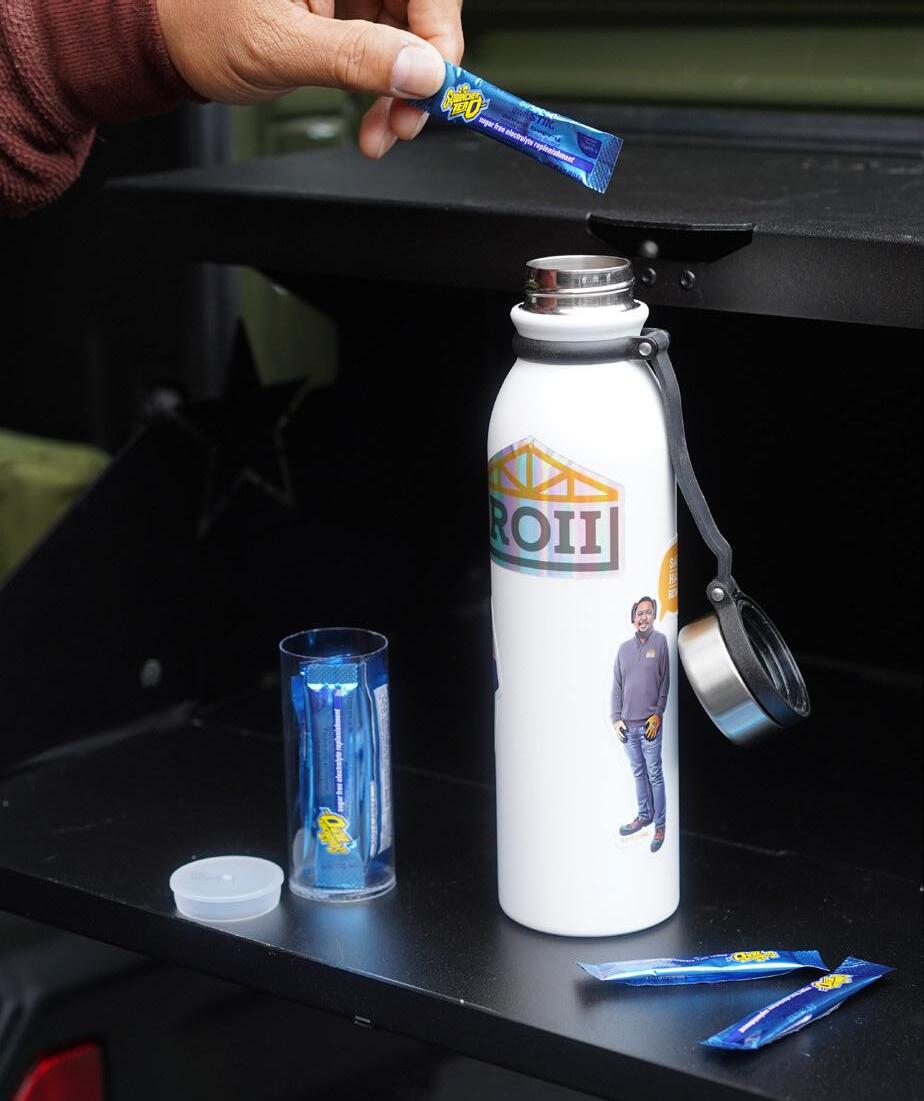

by Leah Jaber ROII Marketing Manager
At ROII, we’re always looking for ways to help our participants prevent injuries before they happen. That means constantly searching for innovative safety products that actually make a difference on the jobsite—not just in theory, but in real-world conditions.
One product that recently caught our attention is SteepGear shorts—a game-changer for anyone working on pitched roofs.
Built-in gripping system
If you’ve ever fallen while working on a roof, you know the immediate
fear isn’t just the trip itself—it’s the slide. Even when a worker is tied off, their rope is often adjusted too loosely to stop them from sliding down the roof. That moment between slipping and reaching the edge is where serious injuries can happen.
SteepGear shorts are specifically designed to address that hazard. With a unique built-in gripping system on the back and thighs, these shorts help workers stop where they land instead of continuing to slide. That instant friction can buy you the time you need to regain balance, signal for help, or simply stay put until you’re ready to move again.

We recently had a serious incident that highlights just how crucial this kind of protection can be. A worker slipped on a roof and, during his fall, instinctively grabbed for anything he could to stop himself. Unfortunately, what he grabbed was the gutter—which caused severe damage to the ligaments in his hands. His rope eventually stopped his fall from hitting the ground, but not before he went over the edge of the roof. It’s the kind of scenario that SteepGear shorts are built to avoid.
This isn’t about replacing your fall protection system. It’s about supplementing it. SteepGear adds an extra layer of defense in the critical moment when a slip happens, and the rope hasn’t yet engaged. It’s simple, practical, and designed with the realities of the jobsite in mind.
At ROII, we believe that preventing injuries starts with smart planning, training, and the right gear. We’re committed to helping our participants stay safe—and that includes introducing them to innovative products like SteepGear that can make a real difference in day-to-day jobsite safety.
If you or your crew work on roofs, these shorts are worth a serious look. Because in this line of work, staying where you land can be the difference between a close call and a costly injury.
Learn more about SteepGear shorts at steepgear.com


Meet the ROII reward most folks hope they’ll never use—but sure are glad to know it’s there. Reward #3 is proof that you have a friend in the L&I world. Because ROII knows the ins and outs of navigating a claim with L&I. You’ll also save an average of 39% on workers’ comp, get tips for keeping your people—and business— safer, and there are no hidden fees or extra charges. No wonder ROII is Washington State’s largest workers’ comp safety program. get help navigating a workers’ comp claim with l&i.

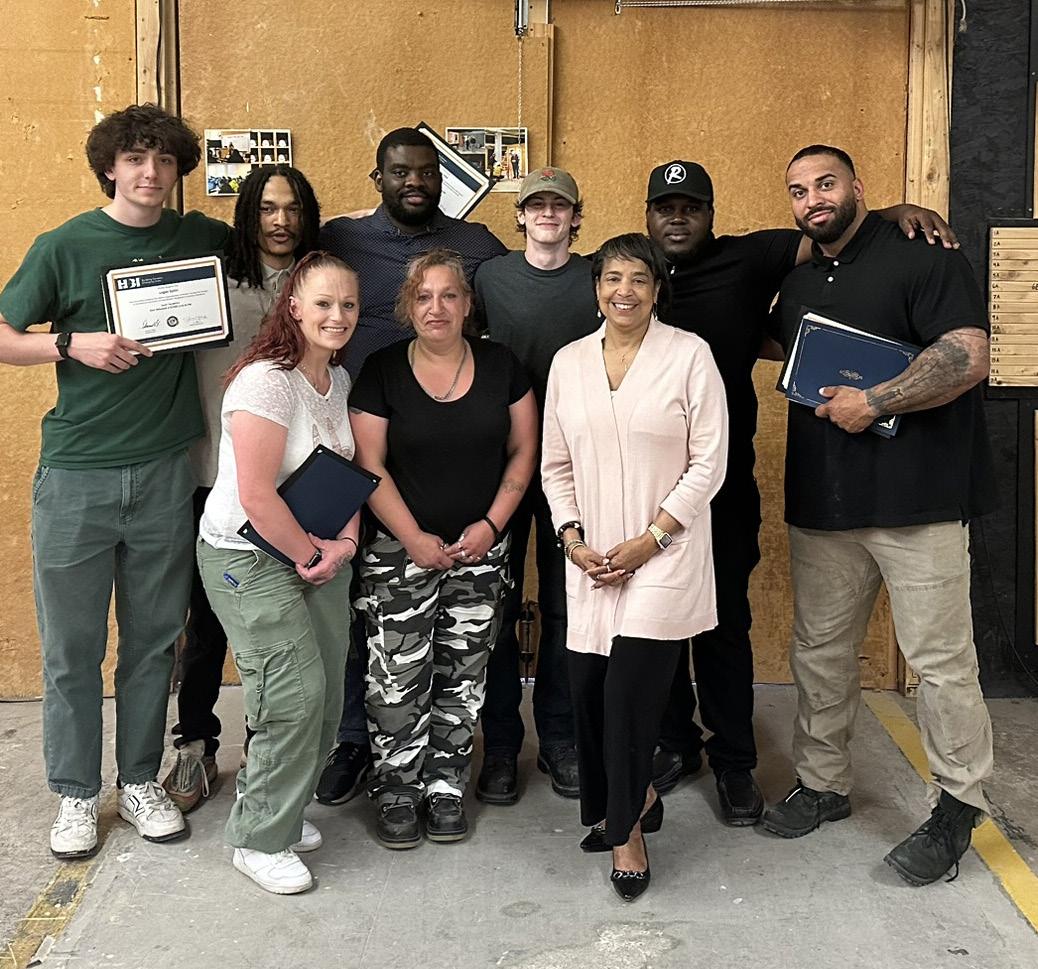
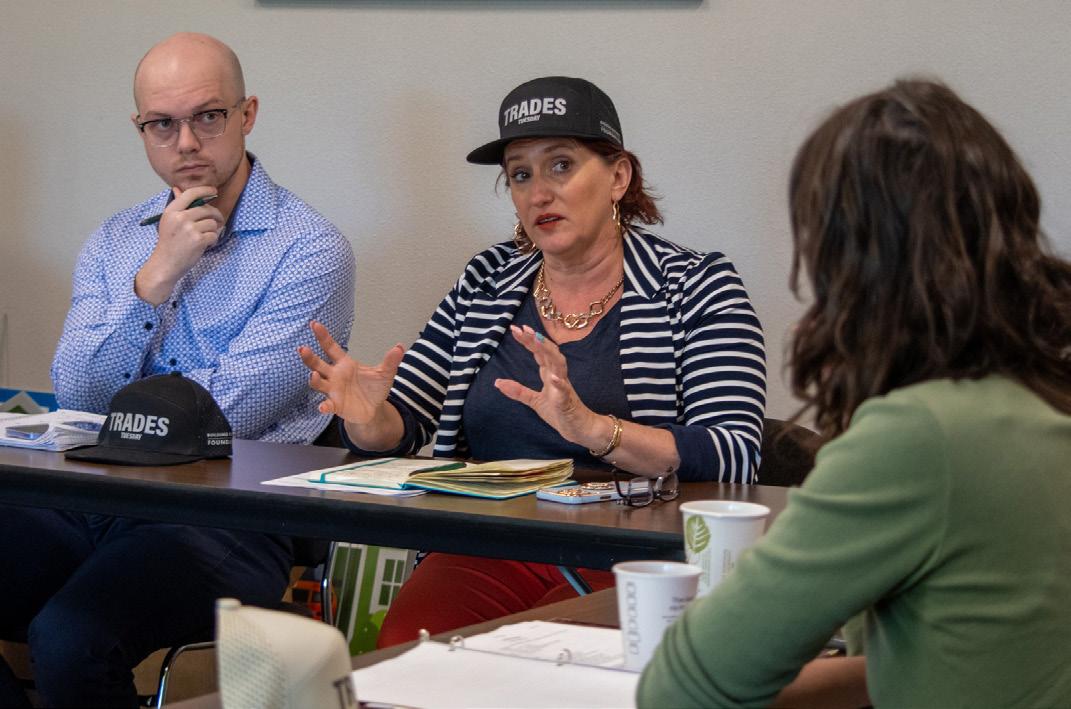

[1] On April 17, the Building Industry Association of Clark County (BIACC) announced the winners of its 2025 Membership Awards Dinner, recognizing outstanding achievements and contributions across the region’s building industry. The event, held at Royal Oaks Country Club, brought together industry professionals, community leaders and partners to celebrate the accomplishments of individuals and companies who exemplify innovation, leadership and excellence. Pictured are the recipients of the Best Specialty Contractor award, Vasiliy and Luba Palchey (l to r) of VIP Custom Masonry.
[2] BIACC members met with Rep. Gluesenkamp Perez to discuss the barriers and challenges the building industry faces. The group discussed ways to keep up with demand, invest in the next generation of tradespeople, and the federal barriers that make housing development more difficult.

[3] A: The second cohort of students from the Washington Home Builders’ Foundation (WHBF) Construction Trades Training Academy (CTTA) completed their training on June 6. B: BIAW Past President Bob Camp spoke during the graduation ceremony, welcoming the students to their new careers. Thirteen students celebrated receiving their PreApprenticeship Certificate Training (PACT) in Construction, and another eight went on to get their PACT Carpentry. The Academy now has a total of 26 graduates. The next cohort is scheduled for July 7 through Aug. 29.
[4] The Olympia Master Builders (OMB) hosted a Kentucky Derby Silent and Live Auction benefiting the OMB Education Foundation scholarship program on June 6 at the Indian Summer Golf & Country Club. The event featured live music, a silent auction and a plated dinner before live bidding began on unique auction packages.






[5] The Kitsap Building Association (KBA) hosted its 2025 Bowling with a Builder event on April 15 at Hi Joy Bowl in Port Orchard. The event offered members an opportunity to meet and connect with fellow members and build lasting professional relationships. Congratulations to Clark Construction Inc., 2025 Bowling with a Builder Champions!
[6] The Building Industry Association of Whatcom County (BIAWC) hosted its 44th Annual Whatcom County Home & Lifestyle Show April 4-6 at the Northwest Washington Fair & Event Center in Lynden. A highlight of the event was the “Ribs & Roofs” BBQ Competition, which raised money for afterschool woodshop programs and the “Pathways to the Trades” Scholarship Fund through Bellingham Technical College. With over 200 exhibitors, the home show is Whatcom County’s largest and most trusted destination for all design and home improvement information, inspiration, offering direct connections with local industry leaders and trendsetters.
[7] The Spokane Home Builders Association’s (SHBA) annual Bull & Crab Feast kicked off on April 17 at Nashville North in Post Falls. Attendees enjoyed a delicious crab and tri-tip dinner and had the chance to bid on tasty desserts from local businesses. Fellow members battled it out on a mechanical bull during a rodeo-style competition. The event raised over $5,000 for the Frame Your Future program, which helps local school districts educate students about careers in construction through hands-on training.

by Bob White ROII Safety Services Director
Washington’s updated outdoor heat exposure rules, which took effect in July 2023, are still in full force as we head into another hot summer. Employers are required to take specific steps to keep outdoor workers safe when temperatures rise, including:
n Encourage and allow employees to take preventative cool-down rest periods at or above outdoor temperature action levels.
n Providing paid cool-down breaks of at least 10 minutes every two hours when temperatures are 90°F or hotter. Breaks get longer and more frequent when temperatures rise to 100°F and beyond.
n Address outdoor heat exposure safety in their Accident Prevention Program (APP) and provide annual training on outdoor heat exposure for employees and supervisors.
n Closely observe employees who may not be acclimatized to the heat and provide all employees with a sufficient amount of cool drinking water and time to drink it as well as adequate shade or alternative cooling methods.
n Have emergency procedures in place to respond appropriately to any employee with symptoms of heat-related illness and supervisors and employees must always have a way to communicate with each other to promptly report heat illness and get medical assistance.
Employers should be prepared to address all the above in their worksite safety plan or “walkaround” safety inspection. If you’re unsure if you comply, take advantage of L&I’s Safety Consultation Services. You can request a consultation, get help with risk management and
ergonomics, or get other safety and health questions answered. Consultations offer many different types of services. They’re free, confidential and safe from citation. L&I safety consultants are your advocates to help protect you from expensive safety citations and maintain a safer workplace. These consultation resources can be found at lni.wa.gov/safety-health/preventing-injuries-illnesses/ request-consultation/
More heat safety resources can be found on L&I’s website lni.wa.gov/safety-health/safety-training-materials/ workshops-events/beheatsmart. Stakeholder meetings for new Indoor Heat Stress Rules may also be coming before the end of the year.
Want to dive deeper into heat safety? Register for ROII’s online Heat Stress Training class on July 15 at roii.com/ classschedule to learn how to protect your crew when peak temperatures strike.

If you are an ROII participant and would like to receive my regular safety updates, including ideas for safety topics, please contact me at (360) 352-7800 ext. 109 or bobw@biaw.com
Not an ROII participant? Visit roii.com to learn more.

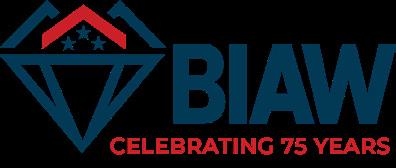
Building Industry Association of Washington
300 Deschutes Way SW, Ste. 300 | Tumwater, WA 98501 (360) 352-7800 | BIAW.com |







